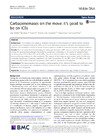
Open access
Date
2018-12-19Type
- Journal Article
ETH Bibliography
no
Altmetrics
Abstract
Background
The evolution and spread of antibiotic resistance is often mediated by mobile genetic elements. Integrative and conjugative elements (ICEs) are the most abundant conjugative elements among prokaryotes. However, the contribution of ICEs to horizontal gene transfer of antibiotic resistance has been largely unexplored.
Results
Here we report that ICEs belonging to mating-pair formation (MPF) classes G and T are highly prevalent among the opportunistic pathogen Pseudomonas aeruginosa, contributing to the spread of carbapenemase-encoding genes (CEGs). Most CEGs of the MPFG class were encoded within class I integrons, which co-harbour genes conferring resistance to other antibiotics. The majority of the integrons were located within Tn3-like and composite transposons. Conserved attachment site could be predicted for the MPFG class ICEs. MPFT class ICEs carried the CEGs within composite transposons which were not associated with integrons.
Conclusions
The data presented here provides a global snapshot of the different CEG-harbouring ICEs and sheds light on the underappreciated contribution of these elements to the evolution and dissemination of antibiotic resistance on P. aeruginosa. Show more
Permanent link
https://doi.org/10.3929/ethz-b-000473515Publication status
publishedJournal / series
Mobile DNAVolume
Pages / Article No.
Publisher
BioMed CentralSubject
Integrative and conjugative elements; Carbapenamases; Pseudomonas spp.; Anitbiotic resistanceOrganisational unit
09497 - Hall, Alex / Hall, Alex
More
Show all metadata
ETH Bibliography
no
Altmetrics


